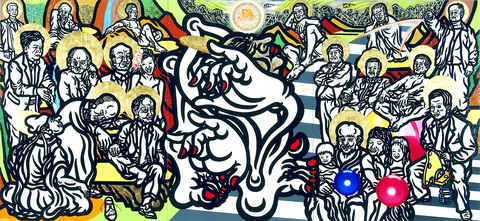According to Mahayana Buddhism, anyone can attain enlightenment, and to assist the masses in reaching that state, known as Nirvana, a number a bodhisattvas and arhats roam the earth as spiritual coaches. Both are considered quasi-deities, but while bodhisattvas resemble Buddha in their appearance and commute between the human and divine realms, arhats look more like monks and live on earth.
In his latest exhibition, Taiwanese artist J.C. Kuo (
Modern-day Buddhist disciples are a concept Kuo began working on in 2000 and each of the arhats is based on male acquaintances of the artist. With strong religious and political overtones, his paintings act as guidelines for living in contemporary Taiwanese society.

PHOTO COURTESY OF MAIN TREDN GALLERY
The walls of the gallery are covered by 20 large paintings, one for each of the arhats and two depicting the cycles of birth and rebirth. The works are rich in color and detail; most use a collage of materials including newspaper print, buttons and jewelry. Kuo's background in woodcarving comes through in his broad brush strokes. The pop-culture and religious iconography are also reminiscent of Roy Lichtenstein's work.
A cautious view of modern technology is a reccurring theme in several of the pieces. In Lohan 7 a man wearing a suit and carrying a notebook computer is surrounded by a multitude of stamps with the words "delete," "shift" and "enter." Similar to other paintings, the man is barefoot, indicating a need to stay grounded and in touch with nature. In Lohan 10 a man is cloaked in a scholar's robe and sits gazing at a mammoth flat-screen TV. The submissive position of the man kneeling in front of the screen indicates a need to question the authority and power of media that has become like a 21st-century religion.
In other works political sentiments are illustrated, such as in Lohan 4 where a middle-aged protester is clad in a white sweat suit and sports both a blue jacket and green headband. Outlining the figure is a burlap sack, which pays homage to the fishermen and farmers who were the forerunners of protest and democracy in Taiwan.

Democracy is also explored in Lohan 1, which shows a man wearing a suit rocking on a toy horse. Above the painting is written the date July 15, 1987, marking the end of martial law. The painting shows Taiwan's young democracy, like a child, needs time to grow and mature.
Traditional Chinese themes of fortune, marital bliss, fertility and long life are also expressed in four of the works. Considering that Buddhist deities are celibate, the inclusion of family men among the other arhats downplays the religious connotations in the exhibit and produces conceivable role models for the real world.
Exhibition notes :
What: J.C. Kuo's 2005 18 Lohans Solo Exhibition
Where: Main Trend Gallery (大趨勢畫廊), 209-1 Chengde Rd, Sec 3, Taipei (台北市大同區承德路三段209-1號)
When: Until April 16. Daily 11am to 7pm. Gallery closed on Mondays.

On April 26, The Lancet published a letter from two doctors at Taichung-based China Medical University Hospital (CMUH) warning that “Taiwan’s Health Care System is on the Brink of Collapse.” The authors said that “Years of policy inaction and mismanagement of resources have led to the National Health Insurance system operating under unsustainable conditions.” The pushback was immediate. Errors in the paper were quickly identified and publicized, to discredit the authors (the hospital apologized). CNA reported that CMUH said the letter described Taiwan in 2021 as having 62 nurses per 10,000 people, when the correct number was 78 nurses per 10,000

As we live longer, our risk of cognitive impairment is increasing. How can we delay the onset of symptoms? Do we have to give up every indulgence or can small changes make a difference? We asked neurologists for tips on how to keep our brains healthy for life. TAKE CARE OF YOUR HEALTH “All of the sensible things that apply to bodily health apply to brain health,” says Suzanne O’Sullivan, a consultant in neurology at the National Hospital for Neurology and Neurosurgery in London, and the author of The Age of Diagnosis. “When you’re 20, you can get away with absolute

May 5 to May 11 What started out as friction between Taiwanese students at Taichung First High School and a Japanese head cook escalated dramatically over the first two weeks of May 1927. It began on April 30 when the cook’s wife knew that lotus starch used in that night’s dinner had rat feces in it, but failed to inform staff until the meal was already prepared. The students believed that her silence was intentional, and filed a complaint. The school’s Japanese administrators sided with the cook’s family, dismissing the students as troublemakers and clamping down on their freedoms — with

As Donald Trump’s executive order in March led to the shuttering of Voice of America (VOA) — the global broadcaster whose roots date back to the fight against Nazi propaganda — he quickly attracted support from figures not used to aligning themselves with any US administration. Trump had ordered the US Agency for Global Media, the federal agency that funds VOA and other groups promoting independent journalism overseas, to be “eliminated to the maximum extent consistent with applicable law.” The decision suddenly halted programming in 49 languages to more than 425 million people. In Moscow, Margarita Simonyan, the hardline editor-in-chief of the